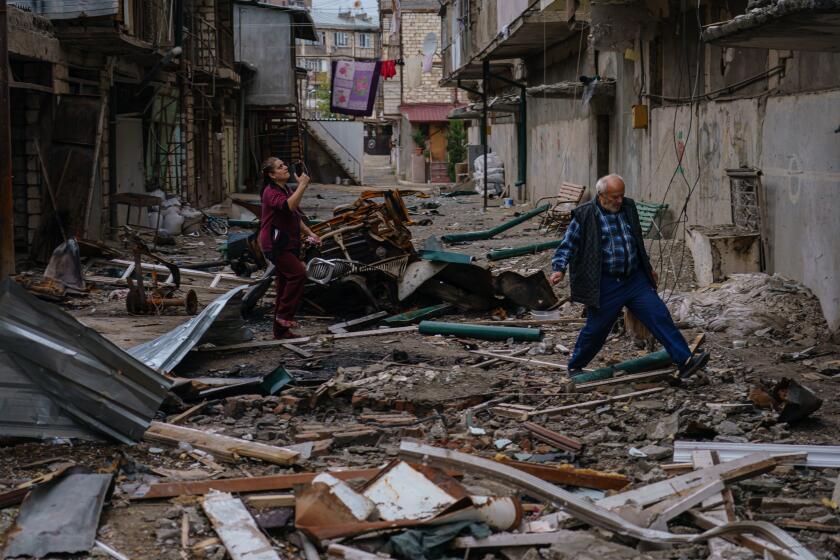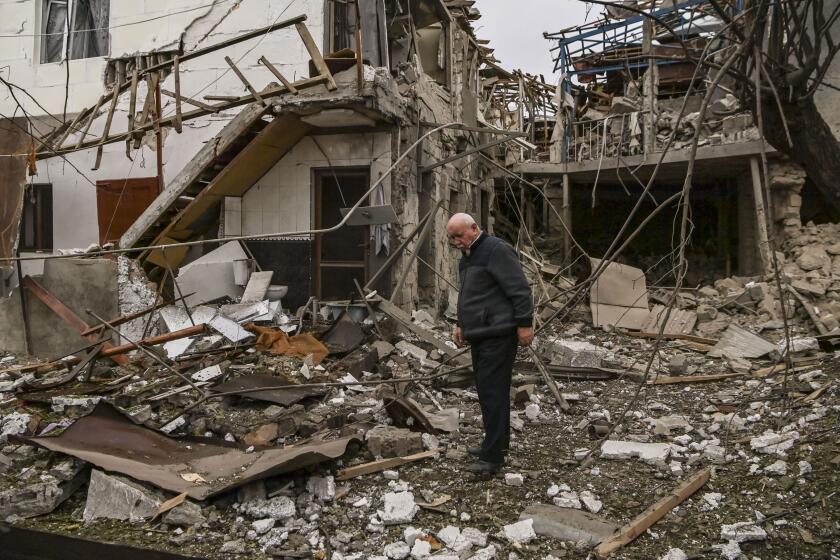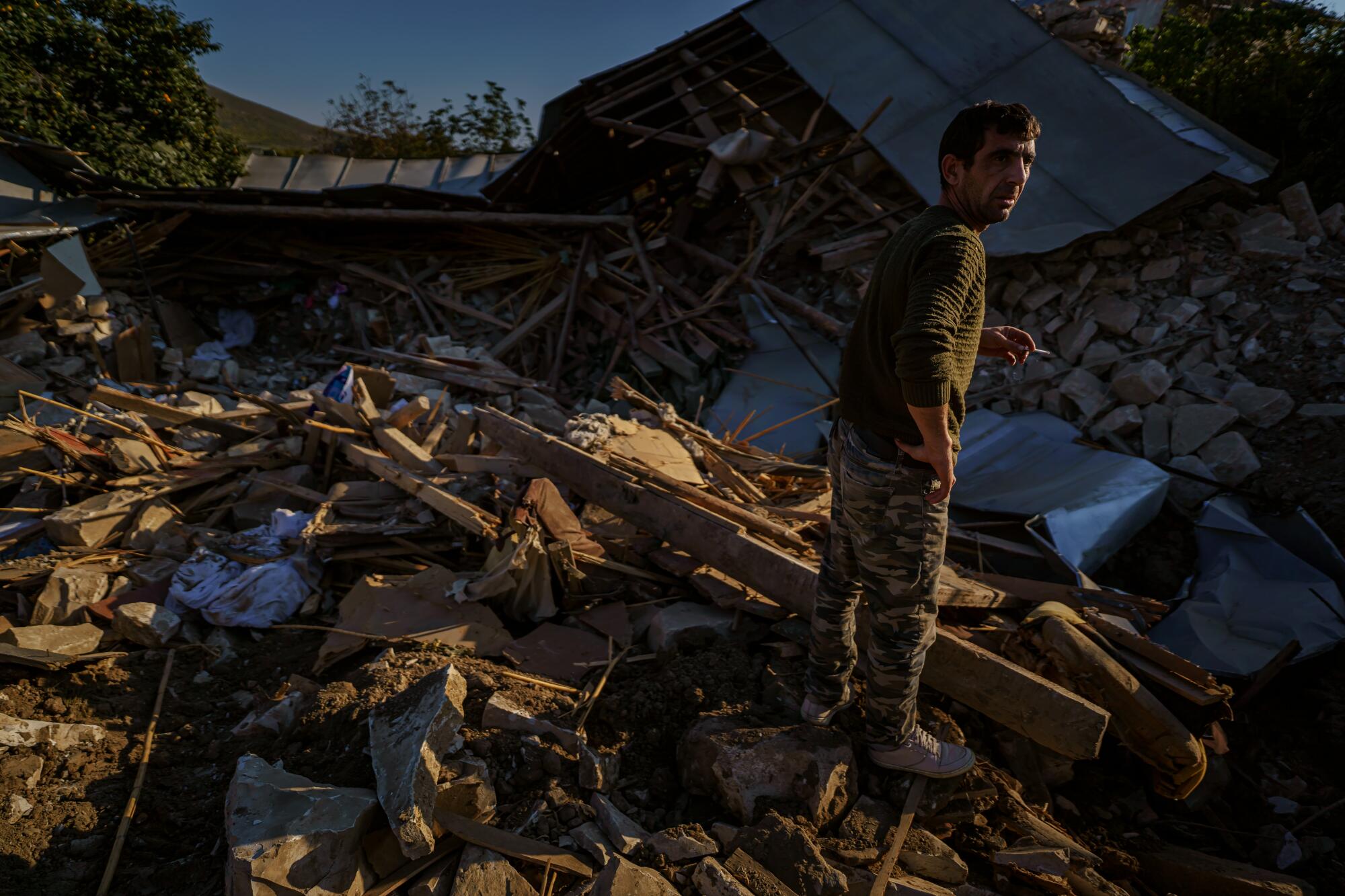
- Share via
MARTUNI, Azerbaijan — Huddled together in the basement of the town’s music school, the women broke into a chorus of bee-like buzzing sounds to describe what has become their greatest fear.
“We don’t see them,” said Katarina Abrahamyan, a 38-year-old supermarket cashier. “We hear them.”
The “them” she was referring to were drones, a frightening new fixture in the military conflict between Armenia and Azerbaijan that erupted in late September after several years of relative calm. Hundreds have now died in more than two weeks of ferocious clashes over Nagorno-Karabakh, the ethnic Armenian enclave internationally recognized as belonging to Azerbaijan but ruled by an Armenia-backed separatist government.
The drones have turned the hostilities from a bloody, bare-knuckled ground fight waged with infantry and Soviet-era ordnance into a deadly game of hide-and-seek against an all-too-patient — and often unseen — airborne enemy.
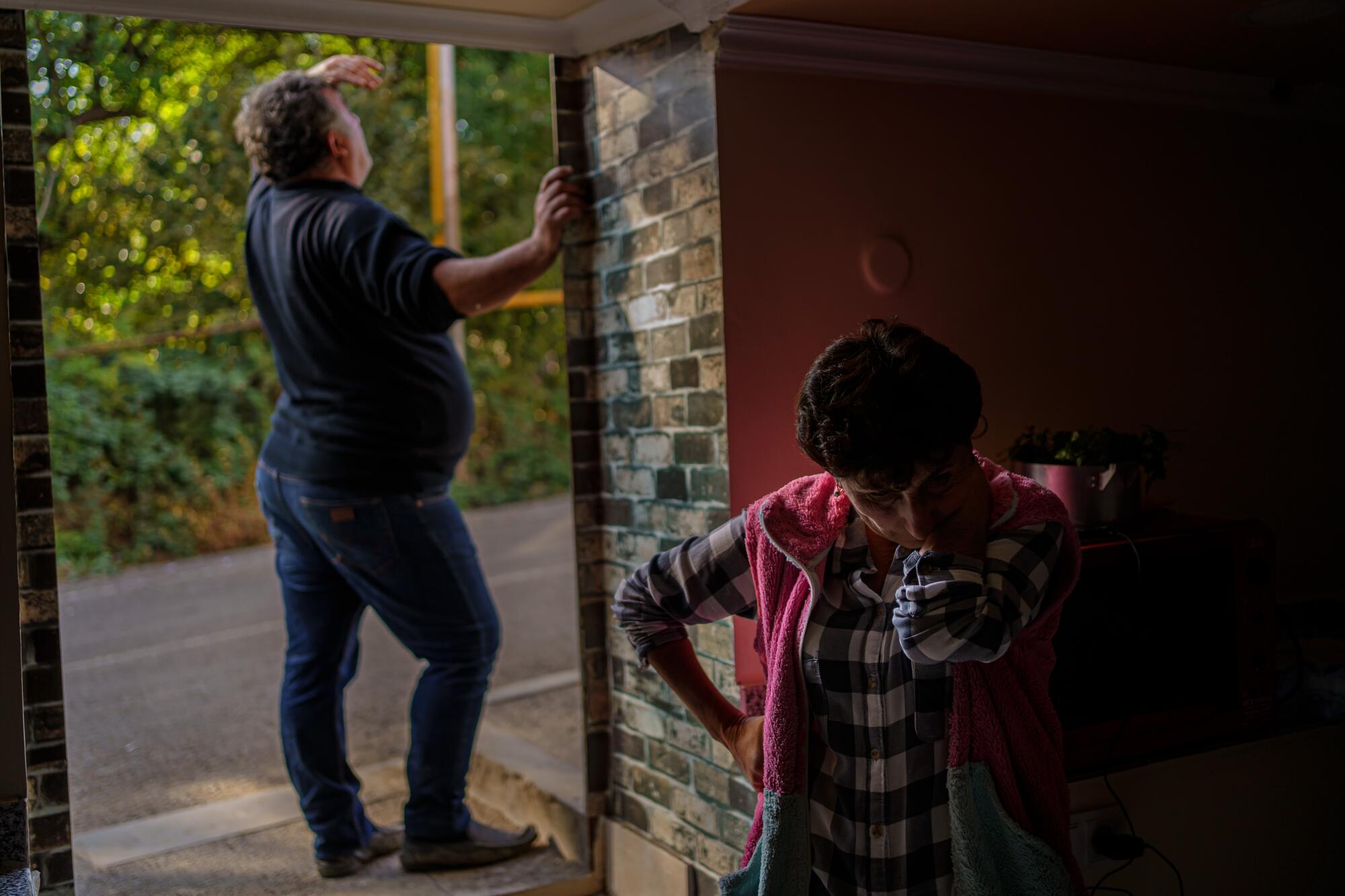
“If we can see it with the eye, we shoot at it. If not, we hide,” said Ashot Sarkissian, a 51-year-old artillery operator keeping vigil in the town of Askeran, just north of Stepanakert, the capital of Nagorno-Karabakh.
“We need new technology. We need new weapons to fight the drones.”
The onslaught from above, which since Sept. 27 has killed five civilians and injured 10 others here in Martuni, a town about 20 miles east of Stepanakert, marks a new and dangerous escalation in the conflict, said Edik Avanesyan, the mayor and a veteran of previous face-offs with Azerbaijani forces.
“The intensity is incomparably higher. Most of these drones are for reconnaissance, and then come the strikes,” he said, adding that so far more than 120 residential and administrative buildings in the town have been damaged, along with 40 cars.
“There are days when they don’t come, but when they do it’s three or four times a day.”
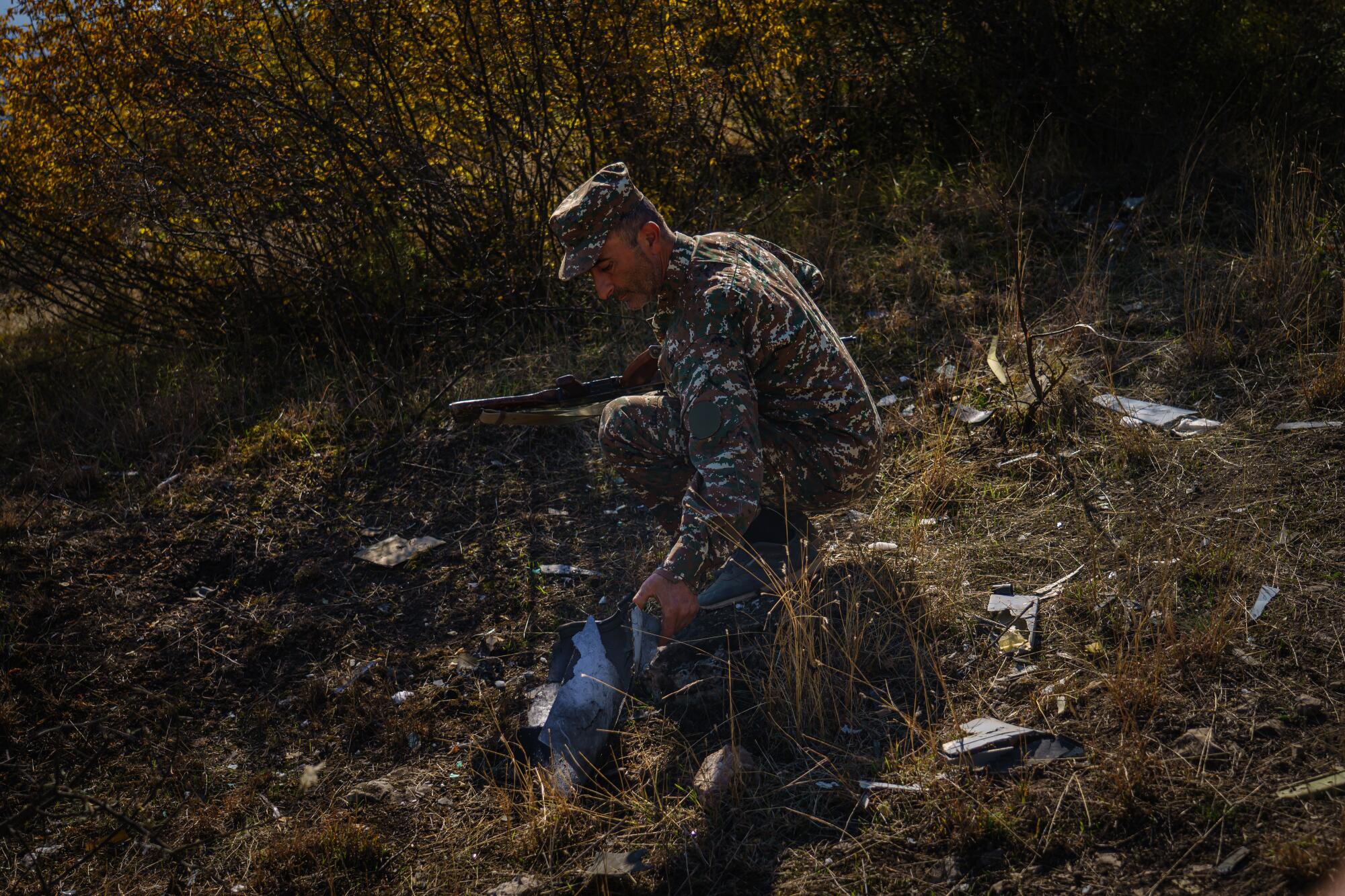
The drone strikes, along with artillery salvos, forced Avanesyan to order an evacuation of most of Martuni’s 6,200 residents, with most women and children seeking refuge outside the town while some of the men stay behind.
The conflict over Nagorno-Karabakh, which ethnic Armenians call Artsakh, dates to World War I, but escalated in the waning days of the Soviet Union. In 1988, ethnic Armenians who formed the majority of the territory’s inhabitants sought to secede from Azerbaijan, a Soviet republic; skirmishes between Armenians and Azerbaijanis metastasized into all-out war as the U.S.S.R. collapsed in 1991.
Three years later, after an estimated 30,000 people were killed in fighting and in pogroms targeting Armenians and Azerbaijanis, a cease-fire was called, leaving Armenians in control of Nagorno-Karabakh, along with a number of other provinces amounting to almost 9% of Azerbaijan’s territory. More than 1 million people, mostly on the Azerbaijani side, remain displaced from their homes, while Nagorno-Karabakh has taken on a totemic significance for both sides.
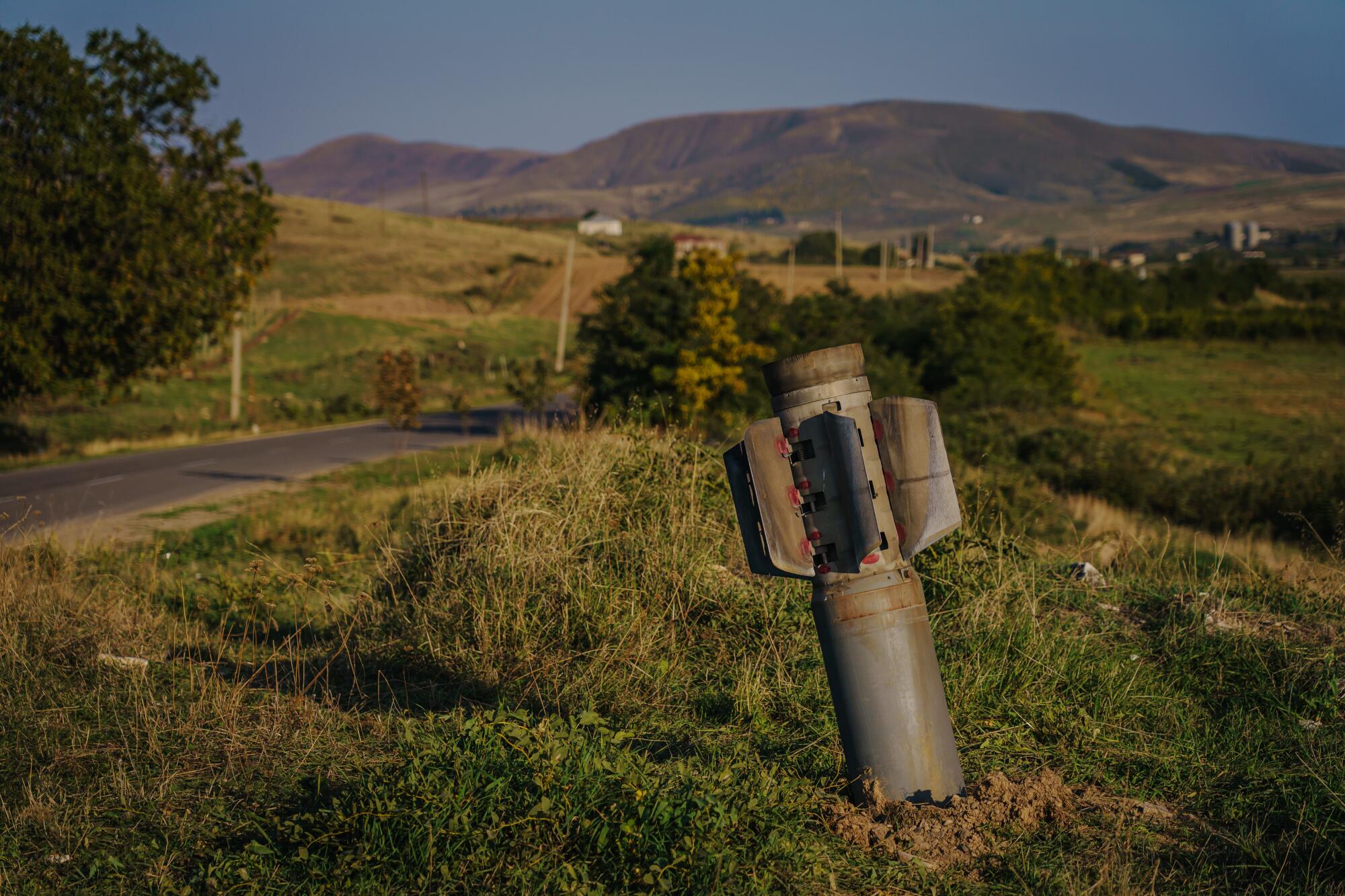
Drones have upended the calculus undergirding that status quo — especially for Azerbaijan, which has used its oil wealth to dramatically upgrade its arsenal, said Rob Lee, a defense expert in the war studies department at King’s College London.
Azerbaijan has vowed to reclaim the mountainous, Delaware-sized territory and launched several offensives over the years. Russia, France and the U.S. — which co-chair the Minsk Group, an 11-country coalition tasked with resolving the so-called frozen conflict — have failed to push the parties toward a final settlement.
“At the beginning of the 2000s, Azerbaijan wasn’t militarily strong enough to retake Nagorno-Karabakh,” Lee said. “But after a sharp rise in global oil prices and a decade of increased defense spending, including tens of billions of dollars spent on Russian, Israeli and other foreign high-tech arms, the military balance of power shifted by 2016.”
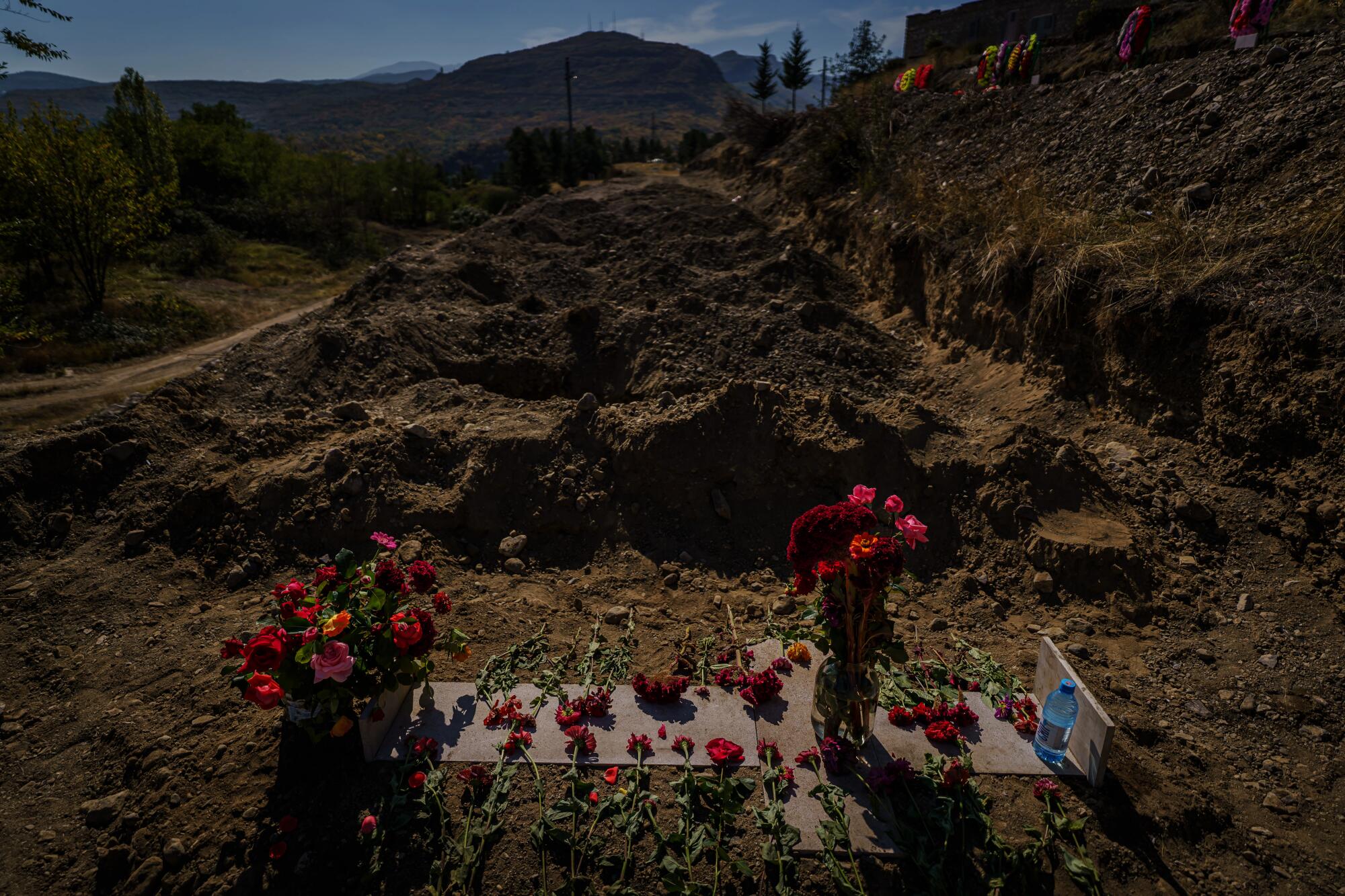
Between 2011 and 2019, according to the Stockholm International Peace Research Institute, which maintains a database on global arms expenditure, Azerbaijan spent more than $19 billion on weapons. That included a $5-billion order with Israel in 2016 for 100 Orbiter 1K and 50 Harop “loitering munitions,” or so-called kamikaze drones that can target antiaircraft defense and radar systems. (The Harop appears to have first been deployed by Azerbaijan’s military in 2016 in a strike against a bus full of Armenian soldiers.)
Armenia has spent about $4.8 billion on its arsenal over the same period, and its reliance on Russia as its main weapons supplier means that its unmanned aerial vehicle, or UAV, capabilities are relatively lacking, because Moscow has not focused its defense development on drones, Lee said. Instead, Armenia has only a small number of domestic UAVs it has employed on the battlefield.
In a nationwide address Friday from the Azerbaijani capital, Baku, President Ilham Aliyev celebrated the shift in his country’s war-making abilities.
“Mediators and leaders of some international organizations have stated that there is no military solution to the conflict,” Aliyev said. “I have disagreed with the thesis, and I have been right. The conflict is now being settled by military means, and political means will come next.”

A new addition to Baku’s arsenal is the Bayraktar TB2, a drone purchased from longtime ally and North Atlantic Treaty Organization member Turkey sometime after June, according to statements given by Azerbaijan’s defense minister to local media. The TB2 has become the favored weapon in the skies for Azerbaijan’s military, overshadowing even the Turkish F-16 warplanes stationed in the Azerbaijani city of Ganja during joint military exercises between Turkey and Azerbaijan.
Aliyev denied that the F-16s have been used in combat against Armenian forces. He instead credited Turkish drones with reducing Azerbaijan’s military casualties in the current flare-up. The TB2 has a flight time of 24 hours and a communication range of almost 100 miles, according to the Turkish government, and comes armed with smart munitions.
“These drones show Turkey’s strength,” Aliyev said. “It also empowers us.”
In recent weeks, the TB2 has made a regular appearance in videos released by Azerbaijan’s Defense Ministry, with feeds from the drone’s high-definition camera (often set to strains of dramatic classical music) demonstrating the drone’s destructive power against older Armenian materiel.
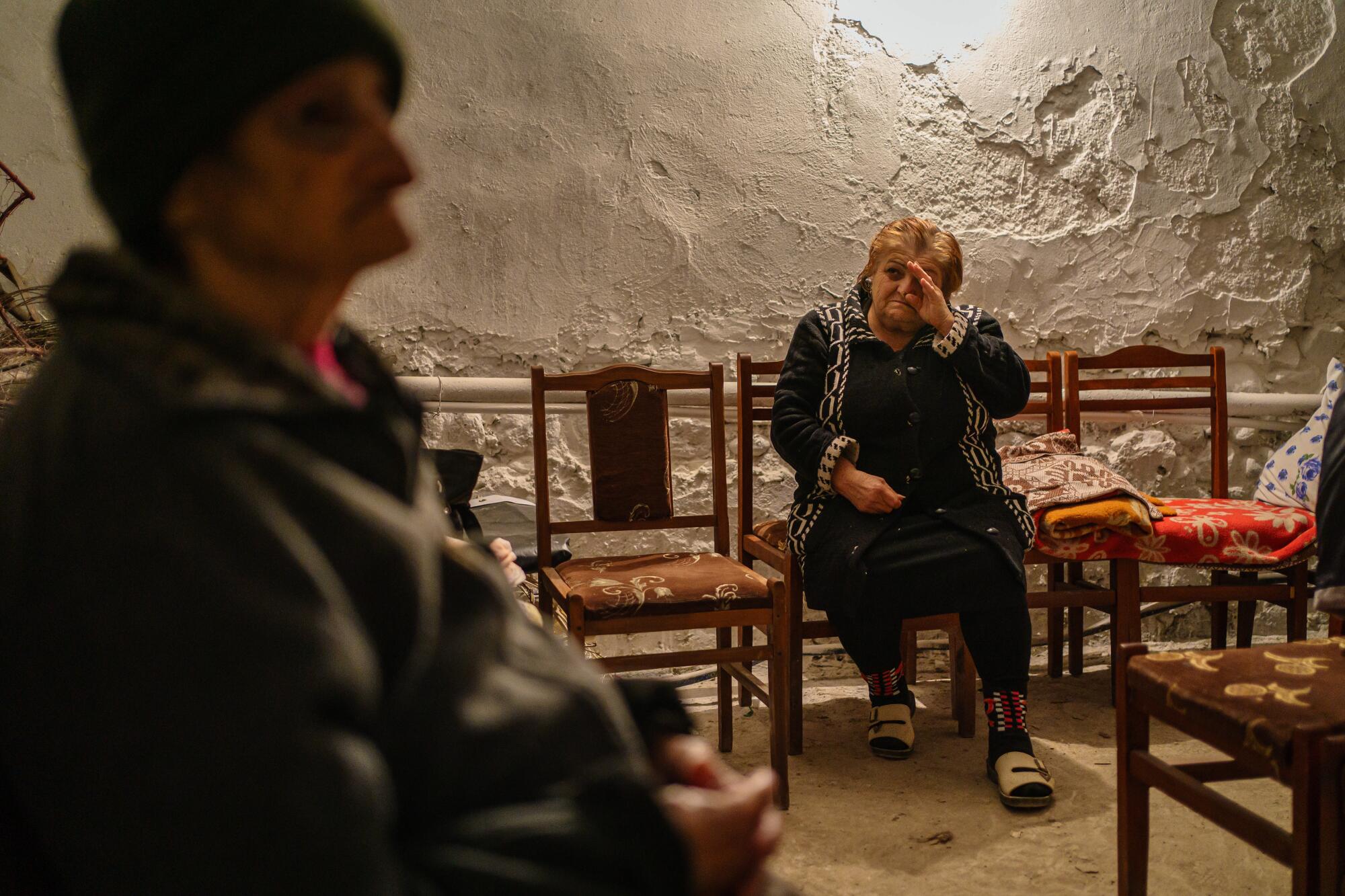
Open-source analysis of such videos indicates that the drones have exacted a devastating toll, disabling some 87 tanks and more than a dozen surface-to-air missile systems. The same analysis shows that Azerbaijan has lost at least 15 UAVs in the fighting.
With the threat of drones omnipresent, officials, army personnel and even civilians have had to alter habits.
In Martuni (which Azerbaijanis call Khojavend), Avanesyan, the mayor, eschews what he considers a less secure but more modern smartphone in favor of a primitive Nokia, which would reveal less information to an adversary. Similarly, soldiers near the front line are proscribed from using GPS or taking any photos with their phones. Drivers tape up headlights or smear mud on their cars to obscure any markings that could make them a target. Gatherings are discouraged, with people urged not to spend too much time in one place and to designate an emergency shelter.
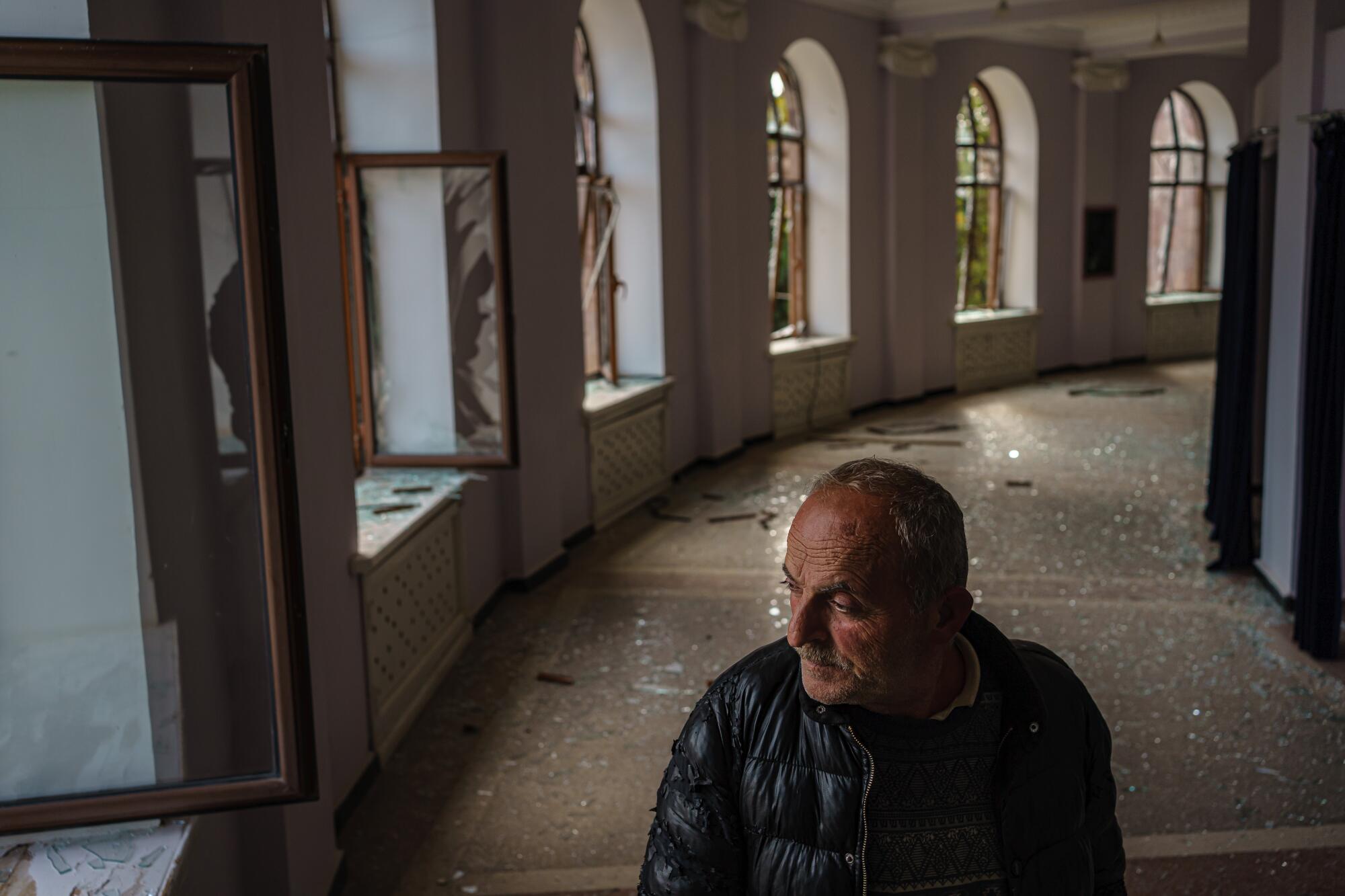
“We can’t stay for long,” said Seyran Danielyan, 63, Martuni’s urban planner, urging a visiting journalist to hurry during a tour of the town. “We don’t know when they’re going to hit.”
Inside the music school, Leonard Hovanissian, a 61-year-old accordion player, sat in the basement near a dusty stack of qanuns, traditional stringed instruments, waiting for the bombing that usually followed the sound of drones overhead.
“We hear the buzzing and we quickly go inside,” he said.
“We’re afraid, and then the sirens begin. It’s as if we’re in the Second World War.”
Times staff photographer Marcus Yam in Askeran contributed to this report.
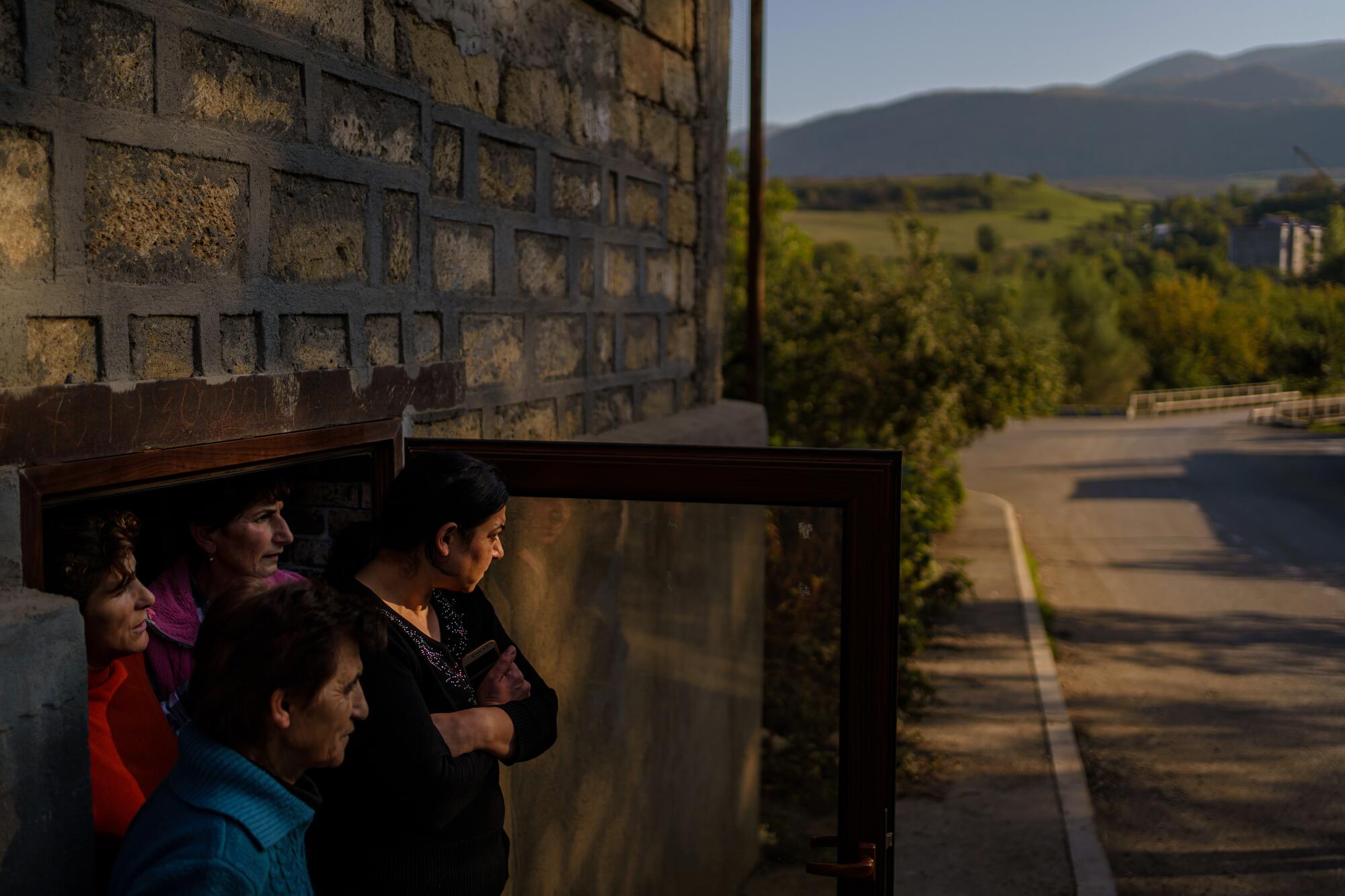
More to Read
Sign up for Essential California
The most important California stories and recommendations in your inbox every morning.
You may occasionally receive promotional content from the Los Angeles Times.
